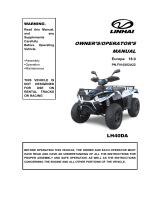
Never operate th is ve h icle on hills
too steep for the vehicle or for your
abilities. Practice o n smaller hills
before attempting larger hills.
Always follow proper procedures
for climbing hills as described
further in this Operator's Guide.
Check the terrain carefully before
you start u p any hill. Never c lim b
hills with excessively slippery or
loose surfaces. Shift your weight
forward. Never open the throt-
tle suddenly or make sudden gear
changes . N ever go over the top of
any hill at high speed.
Always follow proper procedures
for going down hills an d for bra k-
ing on hills as described further in
this Operator's Guide. Check the
terrain carefully before you start
down any hill. Shift your weight
backward. Never go down a hill at
high speed. Avoid going down a hill
at an angle that w ould cause the
vehicle to lean sharply to one side.
Go straight down the hill where
possible.
Always follow proper procedures
for crossing the side of a hill as
described furthe r in this Operator's
Guide. Avoid hills with excessively
slippery or loose surfaces. Shift
your weight to the uphill side of
the vehicle. Ne ver attempt to turn
the vehicle around on any hill un-
til you have mastered the turning
technique described in this Opera-
tor's Guide on level ground. Avoid
crossing the side of a steep hill if
possible.
Always use proper procedures if
you stall or roll backwards when
climbing a hill. To avoid stalling,
use proper gear and maintain a
steady speed w hen climb in g a hill.
If you stall or roll backwards, follow
the sp ecial procedure for braking
described in this Operator's Guide.
Dismount on the uphill side or to a
side if pointed straight uphill. Turn
the vehicle around and remount,
following the procedure described
further in th i s Operator's Guide.
Always check for obstacles before
operating in a new area. Never at-
tempt to operate over large obsta-
cles, such as large rocks or fallen
trees. Always follow proper proce-
dures when operating over obsta-
cles as described further in this Op-
erator's Guide.
Always be careful when skidding
or sliding. Learn to safely control
skidding or sliding by practicing at
low speeds and on level smooth
terrain. On extremely s lippery sur-
faces, such as ice, go slowly and be
very cautious in order to reduce the
chance of skidding out of control.
Never operate this vehicleinfast
flowing water or in water deeper
than that specified in this Opera-
tor's Guide. Remember that wet
brakes may have reduced s topping
ability. Test yo ur brakes after lea v-
ing water. If necessary, apply them
several times to let friction dry out
the pads.
Always be sure there are no ob-
stacles or people behind the vehi-
cle when you operate in reverse.
When it is safe to proceed in re-
verse, go slowly.
Always use the size and type tires
specified f urth e r in this Operator's
Guide
. Always maintain proper tire
pressure as described further in this
Operator's Guide.
____________
SAFETY INFORMATION
____________
11























